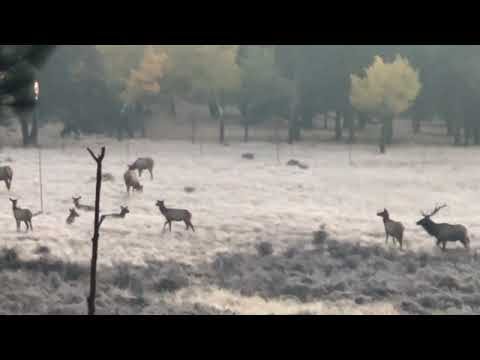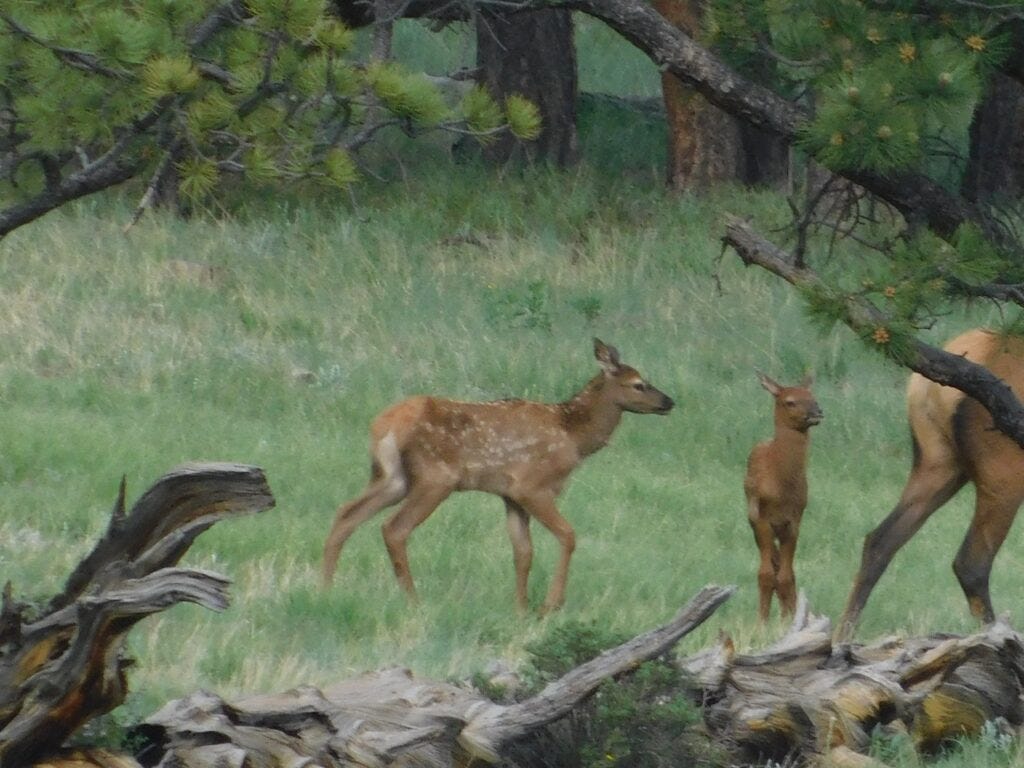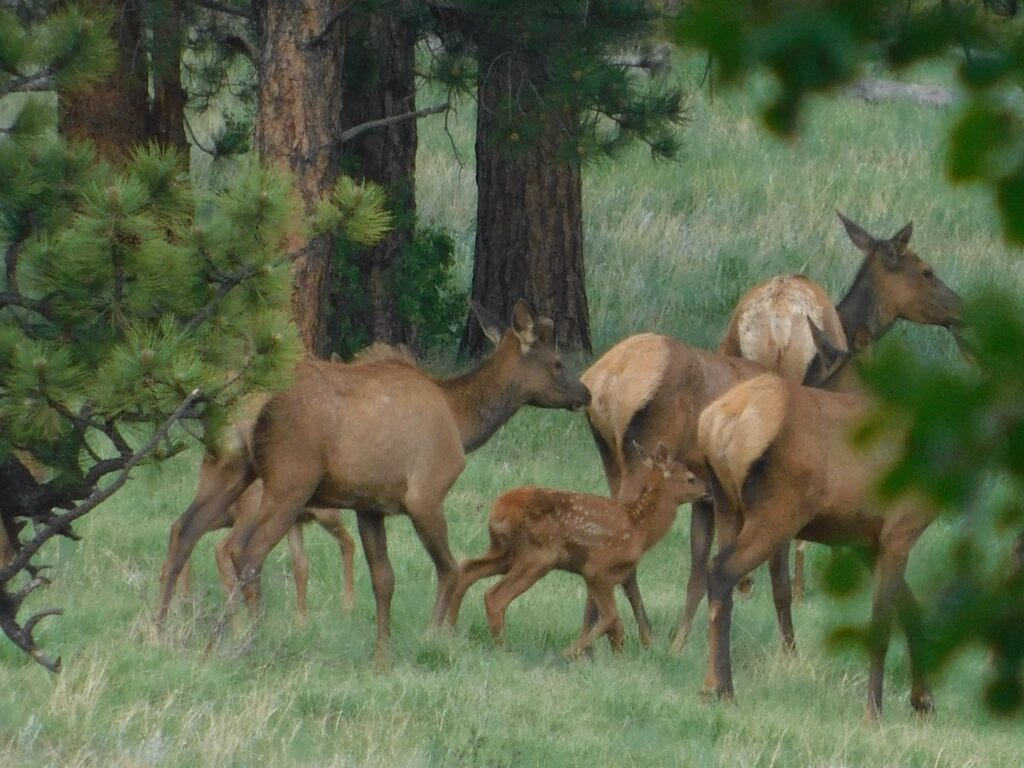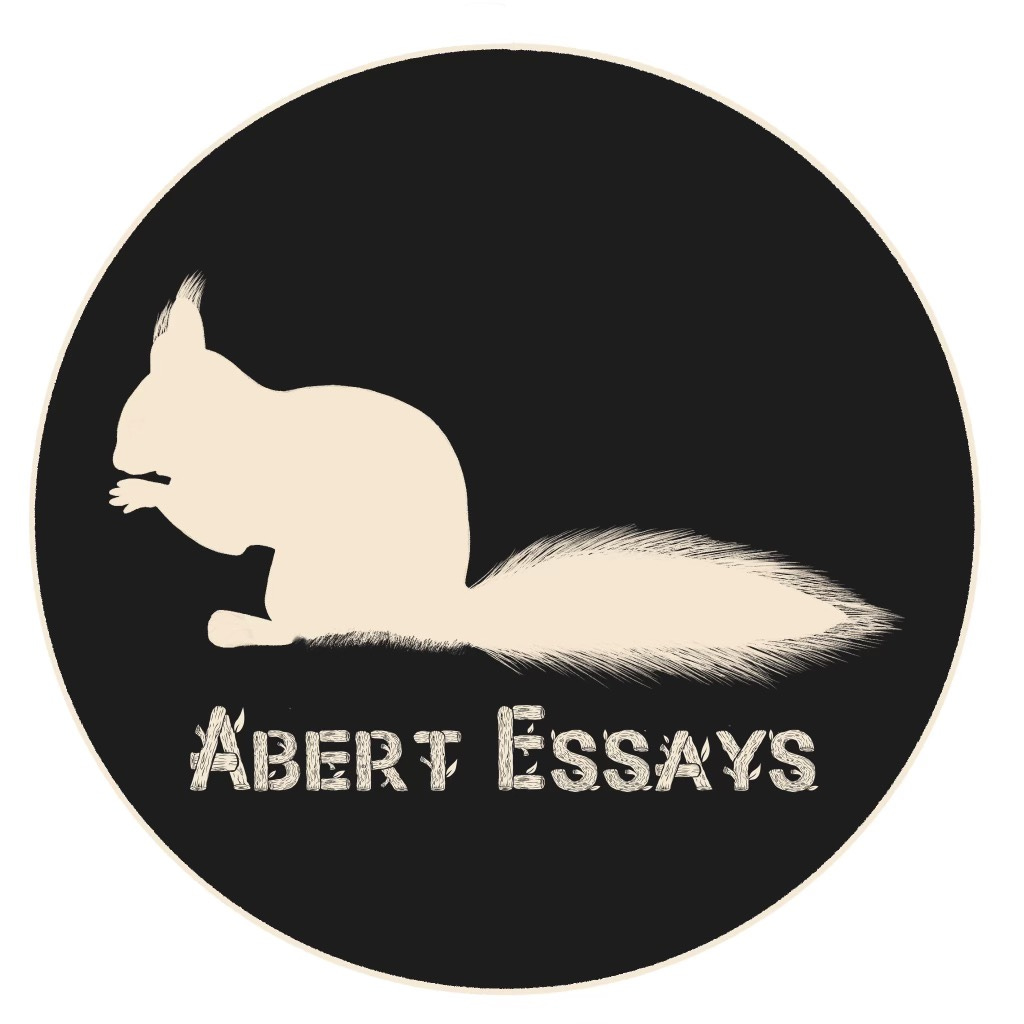Sound on for the video above to hear the elk bugling. This original post from a couple of years ago is good to send out again each fall as the rut is happening. Additional video of elk sparing has been added.
The elk emerged out of the woods and entered the meadow as dusk was falling. As the light dimmed, the noise rose. You might describe it more like screaming than fine bugling, we’ve often commented on what a person completely unfamiliar with the bugle call would think of this shrieking in the dark. It certainly would be a very unnerving experience if you had no idea what it was! The bull elk, who we call, ‘The Dude’, was in fine form that night and got his bugle calls out louder and more patterned than the younger, smaller bucks with their voices cracking like the adolescents they are. ‘The Dude’ wins the ladies.
Colorado is home to the largest population of elk in the world. Over 280,000 reside in the state, with a large concentration here in the Foothills. Ask any Colorado native what the towns of Evergreen and Estes Park are famous for, and the first answer will be ‘elk’. The main season of interest is in the Fall during the ‘Elk Rut’, mid-August through October.
As temperatures cool, especially at night, the biggest, loudest, most aggressive, broadest antlered, bull elk gets the right to gather a harem of cows (female elk) to perpetuate his highly superior lineage to the next generation. This becomes such an obsession the bucks can concern themselves with nothing else, not even food. The noises they make are described as bugles, chuckles, barks, screams, mews, glucks, and chirps. Each sound communicates between herd members to note challenges, warnings, alerts, ‘come hithers’ and worry. It’s an eery thing to wake up to in the early morning hours before your brain can process that it’s the elk outside and not some Stephen King movie scene.
Adding to these calls is the unique cologne that the bulls concoct for themselves. Tearing up a patch of ground with their hooves, they will then urinate in it, (‘impossible amounts of urine’, to quote wildlife photographer, Jared Lloyd), making a sloppy mud puddle. This mud cologne puddle is rolled in by the bull to coat himself and set the scent deep into his neck fur mane. It seems to work on the cows as they sidle up to the loudest, stinkiest bull until another louder, stinkier one comes along. Then it’s time to rumble.
Bulls attack with their polished and sharpened, antler racks, each side weighing 50-80lbs and 4-5 feet wide. In the dark, along with the varied calls, you can hear the clack and crack of antlers. Antlers are often broken in these fights, and many battles are to the death. Stealth photographers with long-range lenses are eager to catch the action. Smart photographers are skilled at not getting too close, Those antlers have turned on many a foolish photographer, vehicle, or tourist with nasty results.
Not present at this party are the young males. For this time at least, they are pushed aside to watch the show in confusion, working through their own hormonal soup. Elk are a tournament species, meaning there is a battle for dominance and the right to breed. A large bull elk in Colorado can top out at over 1100lbs. Those who are old enough to participate challenge the big bulls and find themselves in aggressive fights against sharpened antlers. The rut can be brutal as it is spectacular. Many younger bulls do not live through the fights. As they forgo food as well, losing up to 200 lbs, many starve and become easy targets for coyotes and other predators. Their numbers drop considerably during these months, altering a birth rate of 50/50 male-female down to a 70/30 female-male ratio. A fallen young male elk can feed many other meat-eating wildlife such as coyotes, foxes, bears, vultures, corvids, eagles, pine martens, and mountain lions, down to wasps, beetles, and fungi, which are dependent on this dynamic.
These aren't battles with just one victor, though. Bulls do survive. They gather their own harems in a close-knit group and do their best to keep what they have.
Once the cows are no longer processing cycles of being in heat due to pregnancy, the rut calms down, and they return to mild grazing animals getting along relatively peacefully. But don’t think about getting anywhere near those antlers, they can still re-arrange you if you get too close. Come Spring, you will find the herds together again, with the new calves keeping close to their mamas. And the cycle begins again.
One final note: the rut is dependent on cold temperatures. These huge animals overheat in the rut very quickly, and the rut does not happen (females do not go into heat) unless the temperatures are below 55 degrees. Colorado may someday not have elk present if planet temperatures continue to rise. The elk will migrate north into Canada for the colder climate. Additionally, elk are being pushed into smaller territories due to human development and activity. This can cause areas to be over-grazed and also allow for diseases like Chronic Wasting Disease to spread. Elk are a ‘keystone species’ in the American West, meaning they are a critical part of the environment here. A loss in their numbers and presence would have an effect on many other plants and animals that all function together.
I hope you get to watch and listen to the elk this rut season, from a safe distance. They are breathtaking animals to behold.
📷 All photos are credit: The Abert Essays unless otherwise noted.
📱 Join me on my Facebook page and Substack Notes. I post smaller ‘Encounters’ posts there as I see flowers, animals, weather patterns, and anything else that catches my eye.
Sources:
*This post was originally from October of 2022 prior to my joining Substack. It remains timely though.
Visit Estes Park - https://www.visitestespark.com/blog/post/what-is-the-elk-rut-all-about
Jared Lloyd Photography - Journal of Wildlife photography https://www.jaredlloyd.com/field-notes/chasing-the-rut-part1 and part 4 in email newsletter
https://targetcrazy.com/elk-sounds-meanings









Fascinating! I've watched the rutting season many times in YNP, especially in the Madison. Very ominous about the temperatures affecting mating. Human road systems will exact a murderous toll on northward fleeing elk.